Click to Download the PDF
Download the Word Doc
President’s Message
The groundhog tells us that we’ve got two weeks left of winter, but we haven’t really had any winter yet. Remember the good old days of three feet of snow in a day, towering snow banks along the roadway, hundreds of fish huts out on the main lake, and snow into April. And don’t forget walking to school up hill both ways. But we have this winter pretty well licked now, and spring will be here soon.
By the time you read this, we will know if the Town of Georgina has accepted the recommendations of the document named “The Pioneer Cemeteries Management Plan”, an eighty-page report prepared by LEES and Associates Consulting Ltd. Town Staff has recommended that council accept the report and implement the plan. This will mean that our long-neglected heritage cemeteries will start to get the attention they deserve, slowly bringing them up to a standard that we can be proud of. The Georgina Historical Society hopes to play a part in the rehabilitation, doing volunteer work on cutting back the over-grown bushes and other tasks. This work will be done in co-operation with the Town, and we’ll share details with you as the project unfolds. Your Society has also offered to supply historical and interpretive plaques starting with the Mann cemetery, and hopefully this offer will be accepted by the Town as the project moves forward.
Trenching at the Georgina Pioneer Village is underway, and will hopefully alleviate the spring flooding at the village. We also appear to be making progress on an approved method of access to the caboose, so we can start to think about interior furniture and appointments. If anyone has any ideas or artifacts that you feel will add to the caboose as an educational tool, please contact me or Tom Glover and we’ll work with the Town to implement them.
We are also planning Harvestfest this upcoming September. We’re trying to bring some new and interesting exhibits and attractions to the event, and will be needing volunteers to help us out, so if you can help in any way, please contact any member of the board.
Please remember our upcoming general meeting February 20, being held at the Georgina Centre for Arts and Culture. Mary Pape will be doing a reading from her new book, and it will be an enjoyable evening. I’m looking forward to seeing you all there.
See you soon, Paul Brady
The Lake Simcoe Ice Company By Robert Holden
In the late 19th and early 20th centuries, Lake Simcoe was the scene of frantic wintertime industry as blocks of ice by the hundreds were cut from the frozen surface to fill ice boxes near and far. It was big business as the main method of refrigeration in the 19th and first decades of the 20th century, before electrical powered refrigerators, came from ice carefully cut from the lakes and ponds. Harvested ice was used not only for personal use, but it was vital for the operation of many industries as well.
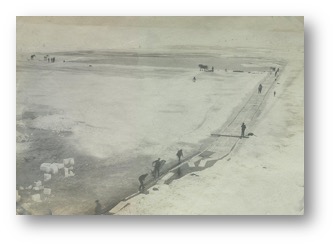
Lake Simcoe ice was considered exceptionally pure and so several large companies that sold ice to Toronto and cities in the United States set up shop on the lake’s shores. Formed by James Fairhead in 1870 to service the Toronto market, the Lake Simcoe Ice Company began as the Spring Water Ice Company. Harvesting was initially done from the frozen surfaces of Lake Wilcox and Bond Lake just north of the city. Lake Simcoe ice had gained a reputation as the best ice in North America. Tested frequently for purity, it always achieved a perfect score. Fairhead expanded his business to Jackson’s Point and renamed his company to Lake Simcoe Ice.
With the advantage of a pre-existing railroad spur line running right onto a wharf next to their facilities the company was able to efficiently ship rail cars of ice to Toronto and all over Southern Ontario and the Eastern Seaboard of the United States. Though many others ventured onto the ice with saw and pike to harvest ice on a smaller scale for local stores and the many summer tourist hotels, camps, and dance halls of North Gwillimbury and Georgina, it was Lake Simcoe Ice that contributed the most to the local economy.
Also, there was the spin-off from businesses serving the needs of the workers themselves; the boarding houses, hotels, and retail stores and suppliers. During the winter months Lake Simcoe Ice became one of the largest employers in Jackson’s Point. Men who worked at the Jackson’s Point lumber mill in the summer would work in the ice trade in winter; a perfect fit because they were used to loading and unloading rail cars.
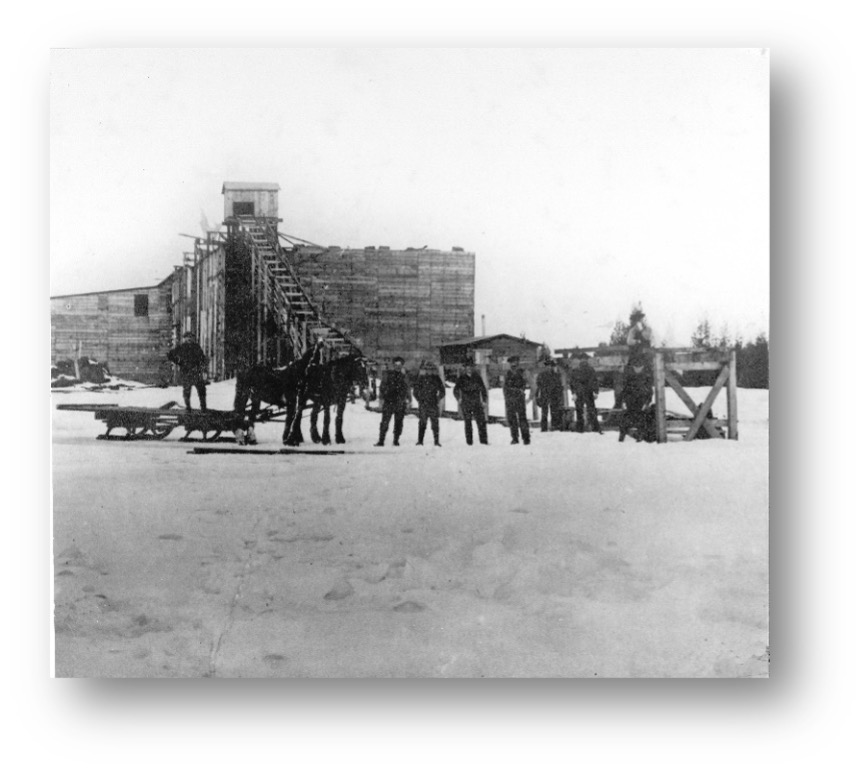

The lumber mill had a derrick, like a crane arm, used for lifting heavy objects. In the winter, it was re-rigged to lift the ice blocks. Railways needed vast stores of ice to cool box cars for the shipment of fruit, vegetables, and meat. They, too, employed many men from Georgina and North Gwillimbury on ice-harvesting crews
Harvesting began in earnest once the ice had reached 10 to 20 inches in thickness which, in a typical year, occurred in early January. It was then a mad dash to bring in the yearly quota before the ice began to melt in March. The process of harvesting ice began by removing snow from the lake’s frozen surface with horse-drawn plows. Then the outlines of ice blocks were marked with charcoal. Often, a horse team would run a plow over the lines, etching deep grooves that would ease the process of sawing. Initially the ice was cut using hand saws, but later huge powered circular saws took over.
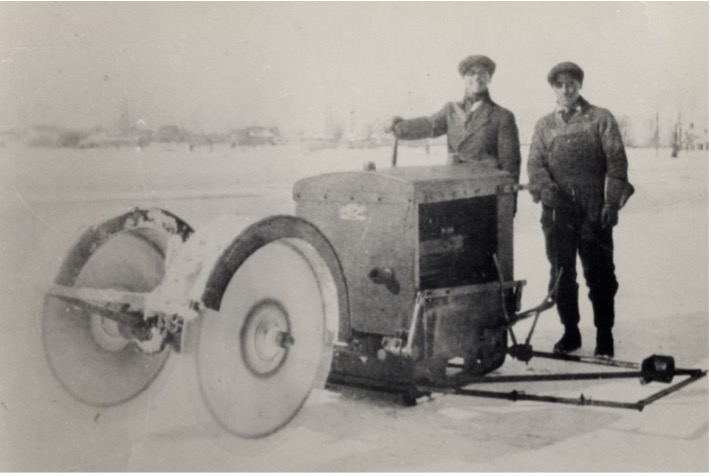
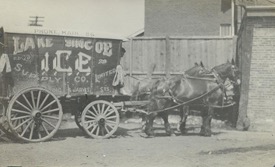
Blocks were brought to shore through channels of open water cut into the ice and guided by men with pike poles. The blocks, often weighing as much as 300 pounds, were then pulled from the water using a jack ladder system like that used in a sawmill and stored in an ice house. Facilities at Jackson’s Point consisted of several massive ice houses with a capacity of more than a thousand tons.. At its height, as many as 40 railway cars of ice were shipped daily in peak season.
Harvesters for the Lake Simcoe Ice Company, earned 30 cents per hour, a very decent wage for the time. The horses employed in operation were those used in the summer to pull the company’s fleet of 25 delivery wagons across Toronto.
One advantage the Lake Simcoe Ice Company had over its American competitors was less loss during transport. Even wrapped in sawdust, as much as 40 per cent of the ice shipped to the United States melted en route. Because of the shorter distance, the loss was far less significant when shipped to Toronto.
By the 1920s, artificial ice began to supplant natural ice; it was less expensive and available year-round. The harvest on Lake Simcoe continued for a few more decades, but slowly melted away with each passing year.
Nena Marsden Bursary Award Winner
The following essay was written by Chloe St. Amant of Our Lady of the Lake Catholic Academy in Keswick and is the award winning submission for our Nena Marsden Bursary this year. Well done Chloe!
William John Potts “Whipper Billy Watson
By Chloe St.Amant

If you have ever heard the quote “They deserve a chance to live life as normally as you or I and we can help them, do it. We can tear down some of those needless barriers that the handicapped face every day” then you would know who William John Potts is. Watson was a lifelong Georgina resident. William was once an avid piano player and a singer in the church choir until one day his brother George convinced him to play hooky and said “Get off that piano and get to the gym”. He attended a wrestling session at the All Hallows Anglican Church gym which changed his life forever and became a Canadian professional wrestler and inducted into the Sports Hall of Fame.
William John Potts also know as Whipper Billy Watson. The name “Whipper” came from his usage of the “Irish Whip” which was when hurling an opponent into the ropes before throwing him over his back.
William was born on July 25, 1915, and lived until February 4,1990 when he suffered a heart attack at the age of 74. Whipper Billy Watson was a world champion. On November 30 his wrestling career ended after being hit by a drunk driver who lost control and slammed into him as he was loading a fireplace screen into the trunk of his car crushing his legs. This caused a knee injury and 3 ½ hours of emergency surgery. He was in a wheelchair for over a year.
A well-known philanthropist in Georgina and director of the Ontario Society for Cripples Children, Watson was always contributing to charities and known to have raised millions for the Easter Seals. He supported children with disabilities and held an annual skate-a-thon. Because of his support the Whipper Watson Therapeutic Pool was opened at Southlake Regional Health Centre. Watson also has a school named after him “WJ Watson Public School” located in Keswick Ontario. The school’s mascot is named “Watson Wildcat” after him. Also, a park “Whipper Watson Park” is home of the top-rated places listed as Sports and Recreation in Keswick. A place for families to enjoy their time outdoors together and splash pad to cool off in.
William John Potts helped spearhead the campaign to build the Georgina Cultural Centre in the 1980’s. This also houses the Stephen Leacock Theatre. Watson is known not only has a wrestler but also known as the “Champion of charity”. He supported the Cystic Fibrosis Foundation; the Hugh MacMillan Centre; the Multiple Sclerosis Society of Canada; the Bob Rumball Centre for the Deaf; and the Canadian Paraplegic Association.
Georgina should be proud of an Icon that lived in their community and helped so many with all his charities across Ontario. I know I am. The Easter Seals campaign is one of the most recognized fundraisings by Billy himself. He began raising awareness and millions of moneys by activities like the “Snowarama for Easter Seals Kids” which has raised over 16 million dollars for Easter Seals. With his donations and campaigns, he was able to bring happiness to children with disabilities. Easter Seals was able to open the Ontario Crippled Children’s Centre, a place for treatment for children with physical disabilities.
William John Potts made the world a better place. He helped improve the communities around him. He positively impacted so many people. He was one on the most well-known philanthropist. He wanted to promote the welfare of others. Even after he was injured and retired from being a wrestler, he donated his time, money skills to help make things better in the world. He himself had become someone with a handicap; he now would struggle and use a cane to walk around.
A lot of people knew of William. Including Joe Persechini who said this; “In the 60s I used to watch him wrestle on CHCH TV at 4 o’clock,” Persechini recalls. After they met in Newmarket that day, the two eventually became friends, and partnered together to raise funds for many local causes: Georgina Cultural Centre (which houses the Stephen Leacock Theatre); Whipper Watson therapeutic pool (at Southlake Hospital); a year-long campaign to buy a CAT scan machine; and many Easter Seals events and telethons.
William touched a lot of lives. There is a huge list of Canadian charities and groups that he helped. He supported the Cystic Fibrosis Foundation; the Hugh MacMillan Centre; the Multiple Sclerosis Society of Canada; the Bob Rumball Centre for the Deaf; and the Canadian Paraplegic Association. William would always say every time he did a speaking engagement “it was like being in a wrestling match” – That he would give all his energy to the crowd, he spoke from his heart, and put feeling into it because the crowd could see it if you didn’t.
I’ve lived in Georgina for 17 years, and it’s nice to know that people like William came from this area; someone that made a BIG difference from a small town. It’s nice to know that Georgina is associated with his name. With his charity work and support for many different causes, I know that people from Georgina would have access to these amazing organizations and groups. Georgina’s heritage is important, and I think it’s important to share stories of those people to the residents of Georgina to let them know that small town people can make big impacts on other people’s lives all around the world. William had a big punch but a bigger heart. It’s nice to know that his name lives on in many charities but especially in Georgina itself, such as the local school and park that is enjoyed by all the residents in Georgina. People will always question who is Whipper? Why is the school called Whipper Watson, or the park Whipper Watson Park? This will lead to research and learning who William John Potts aka Whipper Billy Watson was and where his roots started.
Georgina – A Town of Many Towns North Gwillimbury Lakeshore Communities
By Robert Holden
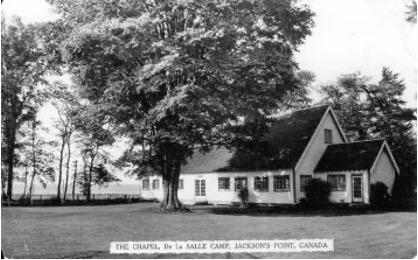
My first introduction to Town of Georgina communities took place as a young teacher at my first school, Deer Park Public School, back in the 1970s. Keswick, Roches Point, and Willow Beach were places I knew, but suddenly I was faced with students in my class from places I’d never heard of… Belhaven, Balfour Beach, Island Grove, Orchard Grove, and Ravenshoe. I soon learned that Georgina was a Town made up of many towns, small villages, cross-roads and lakeshore communities that were scattered throughout the municipality. Our January article focused on many of the inland communities within Georgina; this article will focus on some of the lakeshore communities located within the former Township of North Gwillimbury.
In the Historical Atlas of 1878, North Gwillimbury is described as “delightfully situated being partially surrounded by water” and goes on to state “it enjoys in scenery which no other township possesses. The surface of the land is gently undulating with well cultivated fields, comfortable and often superior dwellings, substantial and extensive barns and out houses.
The roads are generally excellent, and a drive within view of the lake, is in summer one to be desired and remembered.” (1) This description could well be applied today to those more rural or lakefront parts of this former township.
Three of the prettiest communities in North Gwillimbury are Balfour Beach, Eastbourne, and Roches Point. Home to many large estates and homes owned by some of Toronto’s wealthiest families, these three communities have a long history dating back to the 19th century.

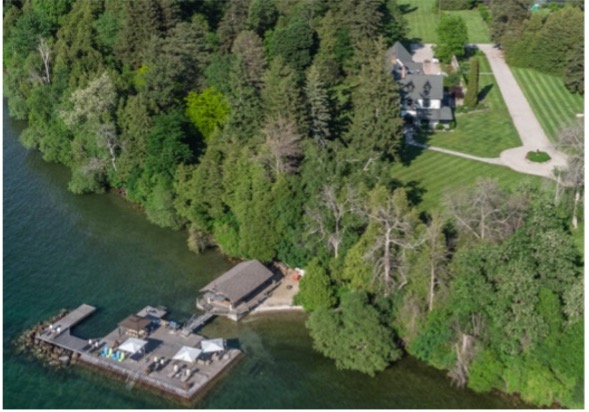
Roches Point was named after Irish settler James O’Dell Roch, who obtained land in the area sometime before 1812 and sold it after being forced to retreat during the War of 1812. It became Government Reserves by 1822, and the name disappeared within the new community of Keswick, beginning in 1824. After the War of 1812 the Roches Point area was considered as a possible alternative capital to replace York (now Toronto), as it was farther from American encroachment. (2) May’s wharf was built by Captain May for his steamboat services on the lake.
It sits upon the property occupied by Lakehurst, a mansion built in 1862. The land was originally owned by Timothy Rogers in 1804, a founder of the Quaker Settlement near Newmarket. Christ Church, an Anglican church in Roches Point (see right), is considered by many to be one of the most beautiful and historic buildings in all Georgina. The building was constructed in 1862 and the first service was given in January 1863. (3) From Roches Point, huge estate properties stretch along the shores of Balfour Beach to Varney Road. It is one of the wealthiest communities in Georgina. Further east is Eastbourne with one of the oldest golf courses in the area.
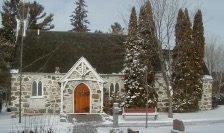

A beautiful 9 hole course, last year it celebrated 110 years of continuous operation. (4)
South of Roches Point in the community of Keswick is Indianola Beach. A popular resort in the early to mid-twentieth century was the Royal Hotel on Cook’s Bay (see left). A little northwards along Church Street in Keswick, just west of Metro Road (the former right of way for the old Metropolitan Railway) sits Elm Croft House, one of many guest houses in the area that served up accommodation to tourists visiting the area in the early 1900s.
East of Eastbourne is Island Grove and the ferry to Snake Island, part of the lands owned by the Chippewa’s of Georgina, an Anishinaabe Nation. In the late 1820’s, the Indian Department of Upper Canada began to relocate the Lake Simcoe Indians. The Indians were blamed for destroying wildlife so they were encouraged to farm. Snake Island was the first island the Indians settled on in Lake Simcoe. With more pressure to farm, they moved to the larger and more isolated Georgina Island. Only a few remained on Snake Island. (5) Further east you pass through popular Willow Beach. Over the decades of the twentieth century, a residential community has developed surrounding the conservation park fronting the beach there.
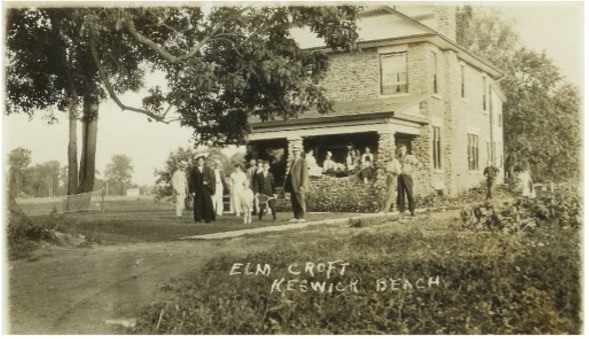

Continuing our tour eastwards, Lake Drive leads us through Franklin Beach and De La Salle Beach areas. Here next to Franklin Beach is the land purchased by the Salvation Army in 1917 to establish a summer camp, but the Army had actually been running summer camps on the grounds for nearly a decade before that.
The Salvation Army Conference Centre & Children’s Camp is still located there. (6) Another popular camp was De La Salle Camp operated by the Christian Brothers from the 1930s to 1980 (see the picture of the chapel at the beginning of this article). One of the cabins was moved to the Georgina Pioneer Village and was used many years by a group of quilters. Known as the Quilter’s Cabin, it is now the home of the Georgina Historical Society.

(1) Illustrated Historical Atlas of York County 1878,ss reproduced bny Mika Publishing, Belleville 1972, page XVIII.
(2) https://en.wikipedia.org/wiki/Keswick,_Ontario
(3) http://rochespointparish.com/history.html
(4) https://www.georginachamber.com/list/member/the-eastbourne-golf-club-582
(5) https://georginaisland.com/writing/history-of-georgina-island/
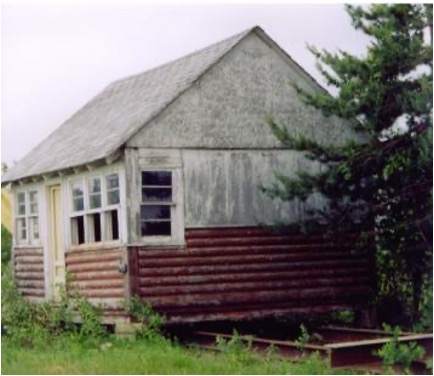
Left – the ‘Quilters Cabin’ in 2006 shortly after it was moved into the village from the old De La Salle campground. It has since been restored and is now used by the Georgina Historical Society.
Where in Georgina?
Our last mystery location was identified correctly by our President Paul Brady. Thanks Paul! It’s finally solved…it was the Orchard Beach General Store! We have a new mystery location below …where is it, and what is it?
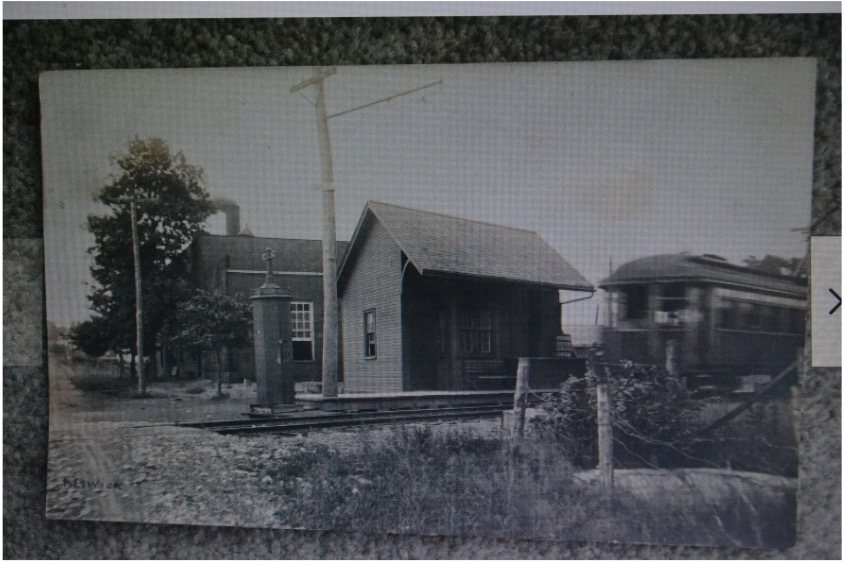
Our Pioneer Ancestors
Adapted from Might’s Directory of 1892-1893 p. 1236 Toronto, Ontario. Below are listed the businessmen in the village.
UIDORA.. A Post 0ffice on Black river (which supplies power), in Scott and Georgina townships, Ontario Co, 30 miles n-w of Whitby, the co seat, 6 1/2 miles w of Sundèrland, on the Mid div GTR, its nearest railway point, and 10 north of Uxbridge, the nearest bank location. It contains a Methodist church and a public school, flour and saw mills. Stage daily to Leaskdale and Sunderland. Pop, 150. Mail daily. R S Webster, postmaster.
Baker M, justice of peace
Brethour A 0, saw mill
Brown Win J, blacksmith
Clarke, Samuel & Wesley, sa,w mill
Clissold Samuel, cooper
Clucley S, mason
Fairfield Bros, masons
Fawne George, live stock
Glide Charles W, harnessmaker
Gordon Wm, planing mill, sash and door mfr
Harvey Bro., saw mill
Keslick Wm, hotel
Peera George, flour mill
Phillips Wm, pumpmaker
Ruttle Charles, carpenter
Sexton 0 A, hotel
Stevenson Bros, carpenters
Taylor Wm & tro, saw mill
Umphrey James W, live stock
Umphrey Michael, saw mill
Urquhart Alexander, carpenter
Webster, R S & Co. General Store; P. O.
News
A hearty welcome to our newest Board Member! Stella Trainor is joining us and has agreed to assume the treasurer’s position. We still need additional directors. If you are interested in playing a role in the work we are doing, don’t hesitate to contact us,
The digitization strategy for the Archives has been approved by Georgina Town Council and may now be downloaded for viewing from the following website:
The Town of Georgina has accepted the recommendations of the document named “The Pioneer Cemeteries Management Plan”, an eighty page report prepared by LEES and Associates Consulting Ltd. Town Staff has recommended that council accept the report and implement the plan. This will mean that our long-neglected heritage cemeteries will start to get the attention they deserve, slowly bringing them up to a standard that we can be proud of. The Georgina Historical Society hopes to play a role in their rehabilitation, doing volunteer work on cutting back over-grown bushes and other tasks. If you are interested in helping out with this work, please contact a Board member.
We have also commenced initial planning for Harvestfest this upcoming September. We’re trying to bring in some new and interesting exhibits, demonstrations, and attractions to the event, and will be needing volunteers to help us out. So if you can help in any way, please contact any member of the board.
Events
Tuesday, February 20 – general meeting at the Georgina Centre for Arts and Culture. 6:30 meet & greet 7:00 meeting; Mary Pape will be doing a reading from her new book.
Monday, March 4, 2024 – board meeting at 2:00 p.m. in the Schoolhouse, Pioneer Village.
Tuesday, March 19, 2024 – general meeting; Sarah Harrison will give a presentation on the Frog Leg Industry in the Holland River.
May 9th & 10th (Thursday & Friday) – Georgina Pioneer Village. Rise to Rebellion
